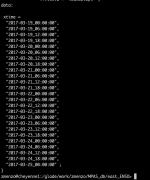Hello,
I am using a sfc_update file for every 6 hours of my MPAS-A run. After successfully running the model for several days, I used the ncl scrip to find the difference between the model output (history) and the sfc_update file to ensure the SST was updating correctly. It seems that for the 0,6, & 12 hours intervals, the SST model output and the sfc_update file match quite well. However, every day, during hour 18, there seem to be significant discrepancies. I have included images to demonstrate the problem. Do you have thoughts on why this may occur?
Thanks as always,
Zach
I am using a sfc_update file for every 6 hours of my MPAS-A run. After successfully running the model for several days, I used the ncl scrip to find the difference between the model output (history) and the sfc_update file to ensure the SST was updating correctly. It seems that for the 0,6, & 12 hours intervals, the SST model output and the sfc_update file match quite well. However, every day, during hour 18, there seem to be significant discrepancies. I have included images to demonstrate the problem. Do you have thoughts on why this may occur?
Thanks as always,
Zach

